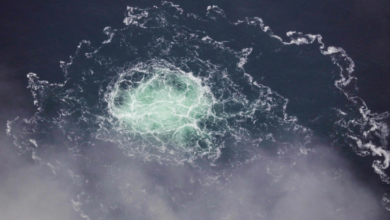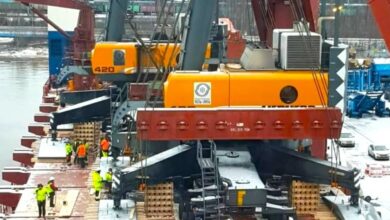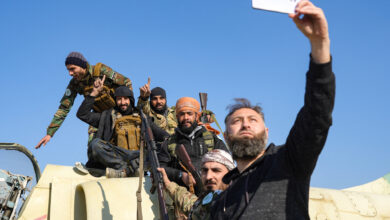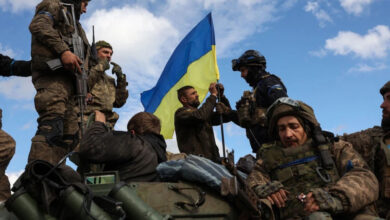In an icy landscape of birches and pines on NATO’s eastern border, this year’s regular military exercises by the alliance have come at a time of spiraling tensions between Russia and the West.
The “Winter Camp” exercise in northeast Estonia, just 100 kilometers (62 miles) from the Russian border, included some 1,300 British, Estonian and French troops operating in extreme conditions.
It comes as Russia amasses troops around Ukraine and demands the withdrawal of foreign NATO forces from Poland and the Baltic states of Estonia, Latvia, and Lithuania, all EU and NATO members.
While there is no perceived threat to Estonia’s own border with Russia, many in the once Soviet-ruled country of 1.3 million people are worried — a concern shared across Central and Eastern Europe.
“We are well aware of what’s going on in Ukraine but we are just acting normally. We don’t see any need for now to increase our readiness,” said Andrus Merilo, a winter camouflage-suited Estonian commander taking part in the exercise.
“We have been ready since 1991,” the colonel said, referring to the year when the Baltics regained their independence as the Soviet Union crumbled.
“We are not afraid of an incursion by Russia… But we also understand that our neighbor may act aggressively and we are ready to counter any aggression from them,” Merilo said.
‘Life Insurance’ for Estonia
Following Russia’s annexation of Crimea in 2014, NATO sent an “enhanced forward presence” of multinational battalions to Poland and the Baltics.
“We are a life insurance for the Estonians,” said Eric Mauger, a colonel in charge of a contingent of some 300 French soldiers deployed to Estonia.
“We are not here to provoke the Russians. Our deployment is preventive, dissuasive and not aggressive,” said Mauger, pointing out that Russia had been informed about the exercises ahead of time.
“But we are ready and able to hold the line while awaiting reinforcements,” he said.
Amid the tensions over Ukraine, the Baltic states have called for an increased presence of other NATO troops as a deterrent against Russia.
Estonian Prime Minister Kaja Kallas discussed the crisis with French President Emmanuel Macron on Sunday, on the eve of his trip to Moscow.
She said the two discussed their shared “commitment to diplomacy and stronger deterrence.”
During the exercise, Estonian soldiers could be seen hiding in a forest and preparing an ambush on tanks maneuvering in a snowy plain nearby.
One of them carried on his shoulder a Javelin anti-tank missile, a weapon Estonia hopes would help hold back any Russian attack while waiting for the alliance to come to its defense.
The NATO deployment “is good because we need tanks to resist other tanks. We don’t have this capacity,” said Estonian Sergeant Major Ivo Perjarv.
He pointed out that, at one point during the exercise, Estonia’s own CV90 combat vehicles were defeated by the French and British tanks.
“Our whole company was destroyed,” he said.
‘The Most Demanding Conditions’
Lieutenant Colonel Simon Worth, commander of the NATO battalion in Estonia, said the aim of “Winter Camp” was to “prove our ability to work in the most demanding conditions soldiers can face.”
Pleased to see the interoperability on display during this year’s Ex WINTER CAMP.
The British and French contingents are sharing knowledge and expertise with one another, as well as their Estonian counterparts. #NATO pic.twitter.com/irSEHGR165
— Brig Giles Harris (@CommanderCabrit) February 5, 2022
Julien, an army captain in full combat gear, said the hardest thing was the terrain.
“As you can see, the weather is particularly harsh and the terrain is marshy which will prevent us from manoeuvring and risks getting us bogged down.
“But this toughens our troops who in recent years have been more used to operating in Mali or Niger. So there’s added value,” he said.
Nearby, a French tank had veered off a snowy track despite its added crampons.
“The cold is tough for our vehicles. We have to look after them to avoid things breaking or the engines stopping,” said Nicolas, a lieutenant colonel.
Under a tent covered with a snow-coloured camouflage tarpaulin, a British soldier, Corporal Liam, was preparing some tea.
“In this weather, cold feet is definitely the most challenging when you are static.”
“The second the cold sets in, life begins to be a lot more difficult. Even walking is a struggle. But once you’ve adapted to it it becomes a lot simpler.”










